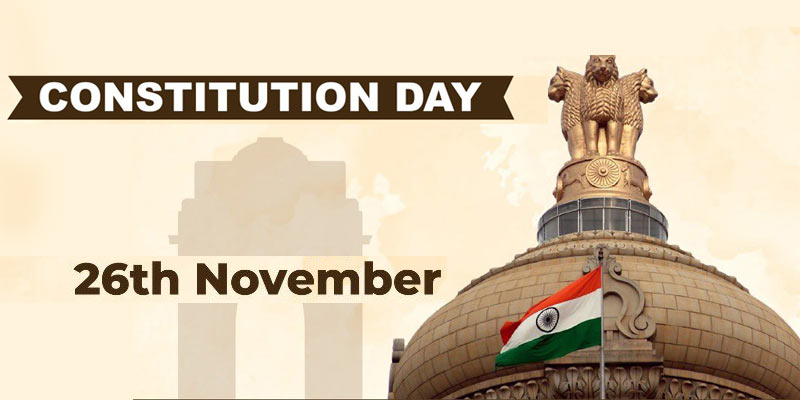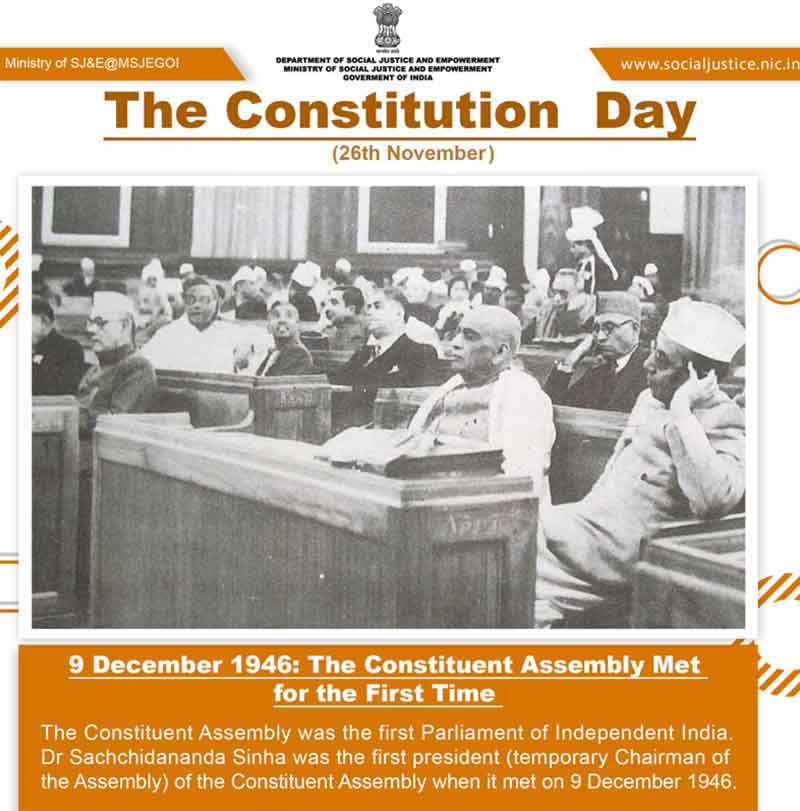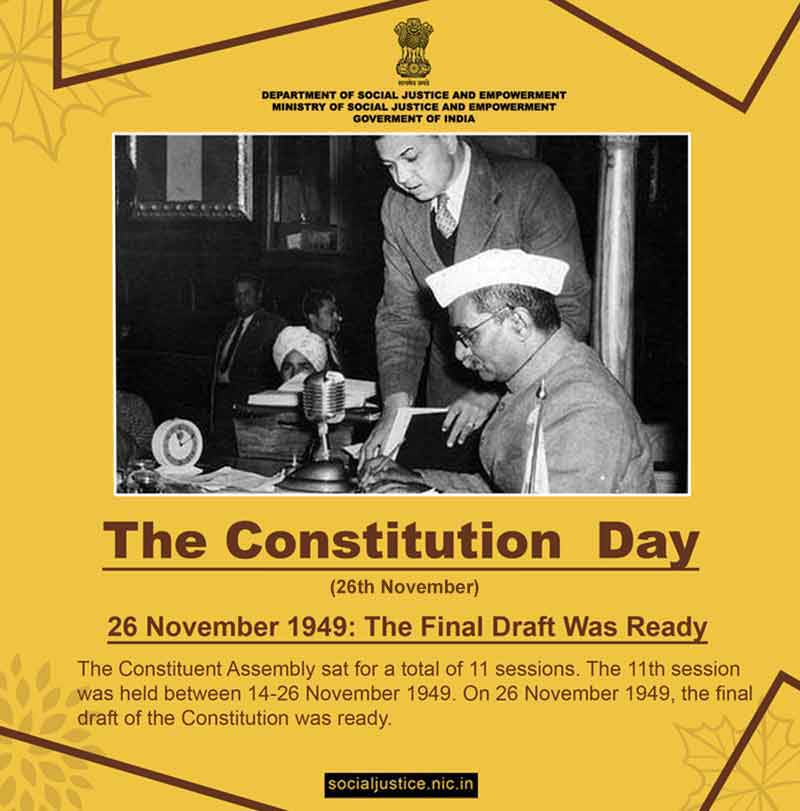- India
- Nov 26
Explainer / Constitution Day
Constitution Day, also known as ‘Samvidhan Divas’, is celebrated in our country on November 26 every year to commemorate the adoption of the Constitution of India.
On November 26, 1949, the Constituent Assembly of India adopted the Constitution of India, which came into effect from January 26, 1950.
The ministry of social justice and empowerment in 2015 notified the decision of the government of India to celebrate November 26 every year as ‘Constitution Day’ to promote Constitution values among citizens.
The Constituent Assembly
• The Constituent Assembly (CA) was set up in 1946 under the leadership of Dr Rajendra Prasad to draft the Constitution.
• The CA took three years (1946-49) to complete the drafting.
• The CA had 299 elected members from Provincial Legislative Assemblies.
• The CA had 13 committees including the drafting committee.
• The Constitution was adopted in 1949 when 284 members signed it, marking the completion of the Constitution making process.
The need for Constitution in a democracy
• In a democracy, the Constitution is a sacred text for the government. It lays a strong foundation for a parliamentary democracy to function.
• The Constitution is the supreme law of a nation.
• India is the largest democracy in the world, and its Constitution serves as a guiding light for it to function smoothly and vibrantly. Ever evolving, the Constitution of India is dynamic and adapts itself to changing times, to address the changing needs and requirements of a developing nation.
• The Constitution of India is the foundational law laying down the basic political structure of India — a Parliamentary Democracy and a Republic with a Federal Structure.
• It defines the three organs of the Republic of India – the Executive, the Legislature and the Judiciary and clearly defines their power as well as demarcates their responsibilities.
The Executive:
• The President of India
• The Vice President of India
• Council of Ministers.
The Legislature:
• The President of India
• Rajya Sabha (The Council of States)
• Lok Sabha (The House of the People).
The Judiciary:
• The Supreme Court
• The High Courts
• The Subordinate Courts.
• The Constitution has mandated several institutional mechanisms like the judiciary, vigilance bodies and an independent Supreme Audit Institution (SAI).
• CAG and the Indian Audits and Accounts Department (IAAD) constitute SAI of India.
• Election Commission superintends, directs and controls all elections to Parliament, State Legislatures & to the offices of the President and Vice-President.
• Union Public Service Commission (UPSC) is mandated by the Constitution for appointments to the services of the Union and All India Services.
• The original copy of the Indian Constitution is 251 pages long. It is the most detailed in the world. The original text of the Constitution contained 395 articles in 22 Parts and eight Schedules. Currently, there are 448 articles in 25 Parts, 12 Schedules with more than 100 amendments.
What is the Preamble?
• A brief introductory statement setting out guidelines for the people of the nation as well as presenting principles of the Constitution.
• Preamble is the preface which highlights the entire Constitution and embodies fundamental values, philosophy & ethos on which our Constitution is based and built.
• It includes Fundamental Rights (Liberty of thought, expression, belief, faith & worship) and Fundamental Duties (Justice, social, economic & political).
• The whole edifice of the Constitution and structure of the political system protect and promote constitutional values embodied in the Preamble.
25 Parts of the Constitution
PART I: The Union and its territory
PART II: Citizenship
PART III: Fundamental Rights
PART IV: Directive principles of state policy
PART IVA: Fundamental Duties
PART V: The Union
PART VI: The States
PART VII: Omitted
PART VIII: The Union Territories
PART IX: The Panchayats
PART IXA: The Municipalities
PART IXB: The Cooperative Societies
PART X: The Scheduled and Tribal Areas
PART XI: Relations between the Union and the States
PART XII: Finance, Property, Contracts and Suits
PART XIII: Trade, Commerce and Intercourse within the territory of India
PART XIV: Services under the Union and the States
PART XIVA: Tribunals
PART XV: Elections
PART XVI: Special provisions relating to certain classes
PART XVII: Official Language
PART XVIII: Emergency provisions
PART XIX: Miscellaneous
PART XX: Amendment to the Constitution
PART XXI: Temporary, transitional and special provisions
PART XXII: Short Tile, Commencement, Authoritative Text in Hindi and Repeals.
Schedules
FIRST SCHEDULE
I - The States
II - The Union Territories
SECOND SCHEDULE
PART A— Provisions as to the President and the Governors of States.
PART B— [Omitted.]
PART C— Provisions as to the Speaker and the Deputy Speaker of the House of the People and the Chairman and the Deputy Chairman of the Council of States and the Speaker and the Deputy Speaker of the Legislative Assembly and the Chairman and the Deputy Chairman of the Legislative Council of a State.
PART D— Provisions as to the Judges of the Supreme Court and of the High Courts.
PART E— Provisions as to the Comptroller and Auditor-General of India.
THIRD SCHEDULE— Forms of Oaths or Affirmations.
FOURTH SCHEDULE— Allocation of seats in the Council of States.
FIFTH SCHEDULE— Provisions as to the Administration and Control of Scheduled Areas and Scheduled Tribes.
PART A— General.
PART B—Administration and Control of Scheduled Areas and Scheduled Tribes.
PART C— Scheduled Areas.
PART D— Amendment of the Schedule.
SIXTH SCHEDULE—Provisions as to the Administration of Tribal Areas in the States of Assam, Meghalaya, Tripura and Mizoram.
SEVENTH SCHEDULE—
List I— Union List.
List II— State List.
List III— Concurrent List.
EIGHTH SCHEDULE— Languages
NINTH SCHEDULE— Validation of certain Acts and Regulations.
TENTH SCHEDULE— Provisions as to disqualification on ground of defection.
ELEVENTH SCHEDULE— Powers, authority and responsibilities of Panchayats.
TWELFTH SCHEDULE—Powers, authority and responsibilities of Municipalities, etc.
Interesting facts about Indian Constitution
• Nand Lal Bose, a pioneer of modern Indian Art, designed the borders of every page of the Constitution and adorned it with art pieces.
• The Constitution was handwritten by Prem Behari Narain Raizada, a master of calligraphic art. Although it took him six months to complete the task, he charged no money for his work.
Manorama Yearbook app is now available on Google Play Store and iOS App Store



